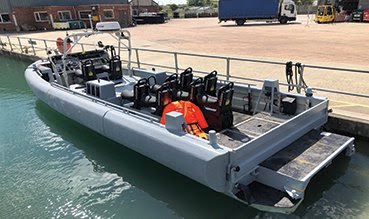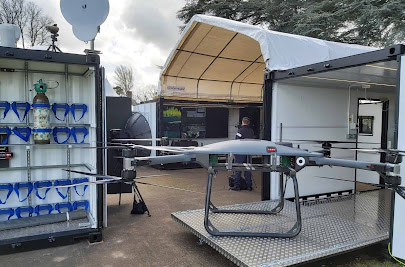Owning the Littorals
What's a Future Commando?
Owning the Littorals is a series by BMR on the merits and capabilities of amphibious forces and what I believe their future should be. View the full series here and part one here.
Over the past 20 years or so, the Royal Marines have found themselves utilised more and more as a plain old light role infantry brigade, taking their turn to deploy on OP Telic and OP Herrick just as much (if not more) than the Army's Brigades. However, with the return to contingency after the conclusion of combat operations in Afghanistan, it was decided that the illusion of a brigade-level amphibious assault should be dropped in favour of a focus on smaller unit tactics and raiding.
This began with experimentation using a company of 43 Commando exercising and wargaming in the UK, US, Gibraltar and Cyprus. The purpose of these was not to thrash the Yanks (which didn't happen) as the tabloids reported, but to try and experiment with how these small unit tactics could affect the battle at higher echelons - it was more fact finding than preparing for any imminent operation.
The Vanguard Strike Company, as it was known, was given lots of leeway to trial and test out all sorts of tactics, small unit structures and equipment, begged borrowed and quite probably stolen from anywhere they could get their hands on. Some of the changes so far are slightly superficial; the adoption of a new uniform, for example, and the White Ensign being worn in the place of the Union Flag - although all these changes seem to be trying to bolster the additional emphasis on the Marines' naval role.
Some changes have not been so superficial though, Vanguard Company have been experimenting with Unmanned Vehicles and loitering munitions (with the Switchblade 300 and 600 reportedly now being in service with the wider Corps) as well as new vehicles, like the allyest of ally wagons - the Polaris MRZR now spreading across the armed forces like an STI.
Most of these changes are intended to reflect upon the Corps' primary role as naval infantry, coming from the sea and melting back into it as soon as they arrived, and illustrating the point that their role is not to deliver massive forces across the shore but to land small groups of elite forces in dispersed spots across a coastline.
These forces could accomplish a wide range of operations, from gathering intelligence, targeting enemy headquarters' with small raids to seizing and holding port facilities to allow heavier forces to disembark.
To accomplish this, the traditional 30 man troop is being replaced by a much smaller 12 man Commando Strike Team, lacking an officer, instead being commanded by a Sergeant. Now - ignoring the obvious parallels with the US Marines micro-platoon, beefy little squad - 12 is a very nice number to work with.
As any of you who learnt your times tables in primary school know, two sixes, three fours, four threes and six twos all equal twelve, taking a two man command element (commander and signaller) two five man teams could be organised.
Now look at the Commando Forces' vehicles; the Wildcat carries six passengers, the Offshore Raiding Craft - eight, the Land Rover Wolf (if it's still going) six. Six Marines is half a troop, meaning two Wildcat's can deliver a troop - or three could deliver a troop and a couple of add-ons with a gunner in each.
It's a similar story with the ORC, a new programme to upgrade the thirty-nine strong fleet is underway - the upgraded model is going to be painted grey instead of the existing green (suggesting a bigger focus further out to sea) and known as the Commando Raiding Craft.
Upgrades seem to include standardising on a forward console (instead of having forward, centre and rear consoles) for the crew, increase the crew habitability and temperature control as much as possible in an open vehicle, upgrade the armour and weapons fit, install a Raymarine Quantum CHIRP navigation radar and a new removable transom for carrying the Commando Inflatable Craft (which has replaced the Zodiac).
It is intended that two CRC's are to support a single Commando Strike Team, with fire and mobility support. For that purpose, all CRC's have mounts to fit either a GPMG or HMG on the port and starboard sides to the aft and a single GPMG mount (intended to be left empty in high sea states and long transits - the planning range is up to 150 nautical miles).
The Royal Marines have acknowledged that this arrangement is sub-optimal - and that one Strike Team should travel in one boat. The Globe And Laurel article which discloses most of this information makes repeated reference to a new boat which 'is already being designed' to replace both the ORC/CRC and the Landing Craft Vehicle Personnel - due to be in service around the 2025 mark.
This aligns nicely with a request for information put out by the Defence and Security Accelerator for a 'novel amphibious craft' able to
- travel at sustained high speeds (at least 25kts) over a long range (up to 350 nautical miles) in Sea State 2
- provide the ability to deliver personnel and light vehicles to a coastal access point with limited or no impact on operational speed/capability
- relaunch and return from the coastal access point
- operate with a low signature across all spectrums (thermal, radar, visual, acoustic, etc) to reduce the probability of detection
It needs to be able to do this with four crew (2 drivers, 1 coxwain, and a load master) while being configurable:
- to carry and deliver up to 24 embarked persons and 4 crew fit to fight (considerations should be given to the environmental impacts on personnel and equipment)
- to carry and secure 2x Light Vehicles and six embarked persons and boat crew (consider for calculations a Polaris MRZR(D). Each vehicle being approximately 3.56m long, 1.86m high, 1.51m wide, Curb weight 953 kg, Payload capacity 680kg.)
- to carry and secure 2x Inflatable Craft and 2x Outboard Motors (OBMs) plus 14 embarked persons and 4 boat crew. (Consider for calculations an inflatable length 5.0m, width 2.08m, height 0.9m, weight 145 kg, Consider a 50hp OBM of 75kg).
This all adds up to being an MOD attempt to see what information they can gain about the potential CRC/LCVP replacement. It seems logical that the Royal Marines would want to replace the ageing LCVP with something that could transport troops at much higher speed, and in much greater comfort than was previously achievable.
The primary downside I can see to this approach is the loss of the LCVP's other role - namely V for vehicle. However, after the Snatch situation in the early 2000's, most vehicles have been getting bigger and bigger so the ability to transport even the lightest of the bunch is getting less and less useful - above the likes of the MRZR and Skidoo sit Jackal, which I've never seen in an LCVP.
Assuming, however, the compartment for the two MRZRs is 7.5m long, 1.8m wide and 1.85m tall (which seems like a probable size needed to quickly manoeuvre out of) then seven NATO standard pallets could be accommodated inside the boat.
We can also see the new 12 man centric theory at work again - each boat could carry two Strike Teams, Half a Strike Team on MRZRs or a Strike Team and two more Marines to operate the Commando Inflatable Craft.
Another innovation of the Future Commando Force is the use of drones, Unmanned Aerial Vehicles, Uncrewed Air Systems or whatever we're calling them this week. (I'm going with Unmanned Systems, or the RAF's RPAS initialism - and I'm dying on this hill).
Although not only a Commando Force innovation, small RPAS are featuring heavily in basically everything the Royals are doing, in use for practically anything - from improving situational awareness at the section level to blowing stuff up.
The RPAS are complemented by the Android Team Awareness Kit (or iPad, to you and me) allowing commanders at the lowest level to improve situational awareness, whether by linking to data feeds and live imagery from his own organic man-portable RPAS or receiving images from higher level reconnaissance assets.
These include several different types ranging from the Anduril Ghost, a man portable design, all the way up to the G3 Systems designed Heavy Lift UAV. The Ghost has a maximum flight time of 55 minutes, can be readied for operation by a single operator in three minutes, is capable of operationg near-autonomously in swarms and is practically silent.
The Heavy Lift UAV was procured under the PODS umbrella, meaning that everything needed to operate the system, and the system itself, is contained in a 20 foot ISO container - improving deployability greatly. (As an aside, sticking one on the River class OPV in the Caribbean would probably help in hurricane season.)
Having the ability to carry relatively large payloads will significantly aid the Commando Forces' ability to transport heavy equipment without having to drag it around - and the ability to transport a casualty is interesting, to say the least.
It is also known that Switchblade loitering munitions are in service with the corps, but not to what extent.
Switchblade 300 is a small (about two foot) loitering munition which can be transported and operated by a single soldier - the whole system weighs less than 3 kg. It has a maximum range of 10kg and a ten minute loiter time. Handily, it is controlled by a ground control system identical to that of the Puma UAV (also in RM service), and both platforms can theoretically be controlled by the same station simultaneously. The explosive is roughly equivalent to a 40mm grenade, and has been air launched from a USMC Osprey - perhaps this could be a useful addition to the Wildcat (in army service as well).
It's big brother, the Switchblade 600, weighs significantly more - the full system being over 50kg - but can be assembled in less than ten minutes, and breaks down to technically man portable levels (although the man porting it would probably disagree). It has a maximum range of 80 km (although relay stations need to be utilised to achieve this) and a 20 minute loiter time at 40 km - the punch is a similar warhead to that found on a Javelin ATGM, giving indirect anti-tank capabilities to the Marines.
More unmanned systems are either in service or soon to be in service but, like much of the FCF programme, not much is known and press releases are very limited.
In the next part of this article, we're going to discuss what I think the Commando force can and should provide at readiness for amphibious raiding, assaults, exercises and disaster relief.








No comments:
Post a Comment